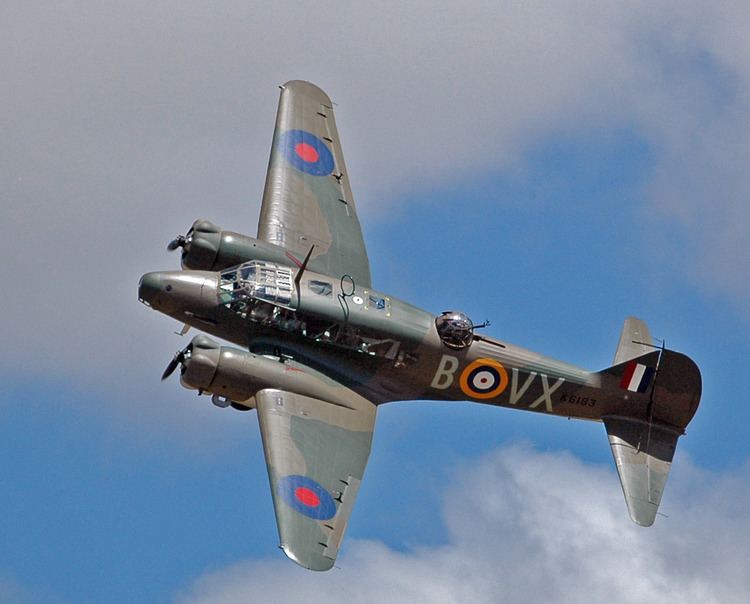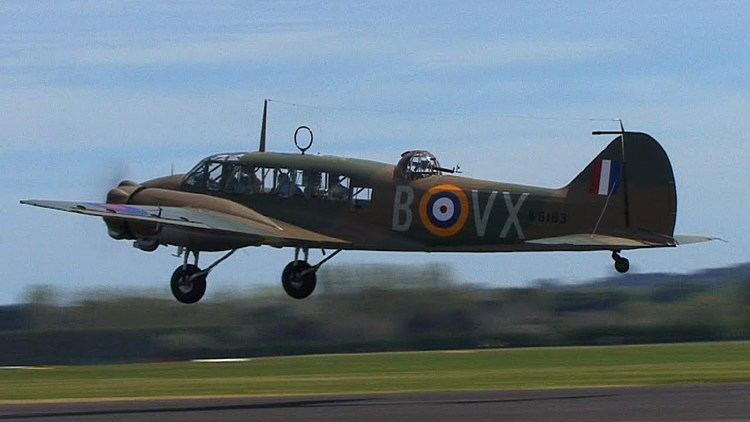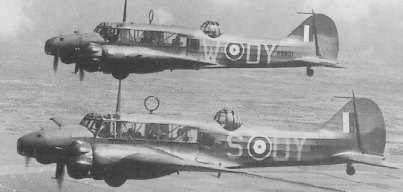Top speed 303 km/h Wingspan 17 m Retired 28 June 1968 | Length 13 m Introduced 1936 First flight March 24, 1935 | |
 | ||
The Avro Anson is a British twin-engined, multi-role aircraft that served with the Royal Air Force, Fleet Air Arm, Royal Canadian Air Force and numerous other air forces before, during, and after the Second World War. Developed from the Avro 652 airliner, the Anson, named after British Admiral George Anson, was developed for maritime reconnaissance, but found to be obsolete in this role. It was then found to be suitable as a multi-engined aircrew trainer, becoming the mainstay of the British Commonwealth Air Training Plan. By the end of production in 1952, a total of 8,138 had been built by Avro in nine variants, with a further 2,882 built by Federal Aircraft Ltd in Canada from 1941.
Contents
- Avro 19 avro anson ww2 bomber trainer
- Design and development
- Operational history
- Postwar civil use
- Accidents and incidents
- Variants
- Operators
- Australia
- Canada
- Ireland
- Netherlands
- New Zealand
- United Arab Emirates
- United Kingdom
- Specifications Mk I
- References

Avro 19 avro anson ww2 bomber trainer
Design and development

In 1933, the British Air Ministry proposed that the Royal Air Force (RAF) acquire a relatively cheap landplane for coastal maritime reconnaissance duties, as a supplement to the more capable, but expensive flying boats that the RAF used for maritime reconnaissance. The Air Ministry requested tenders for aircraft to meet this requirement, with Avro responding with the Avro 652A, a modified version of the Avro 652 twin-engined, six-seat monoplane airliner. The Air Ministry placed orders with Avro and de Havilland for single examples of the Type 652A and the de Havilland DH.89 for evaluation against this requirement late in 1934, with evaluation and selection of a design for production to take place by May 1935. The Avro 652A first flew on 24 March 1935 at Avro's Woodford factory, and was evaluated against the DH.89M by the RAF Coastal Defence Development Unit at Gosport from 11 to 17 May. The Avro aircraft proved superior, and was selected as the winner of the competition on 25 May. Air Ministry Specification 18/35 was written around the Type 652A, and an initial order for 174 aircraft, to be called "Anson", was placed in July 1935. The first production Anson made its maiden flight on 31 December 1935; changes from the prototype included an enlarged horizonal tailplane and reduced Elevator span to improve stability. Deliveries to the RAF began on 6 March 1936.

The Anson Mk I was a low-wing cantilever monoplane with a retractable undercarriage, the first type with this configuration to enter service with the RAF. It had a wooden wing, of plywood and spruce construction, while the fuselage was constructed of steel tubing, mainly clad in fabric, but with the aircraft's nose clad in magnesium alloy. It was powered by two Armstrong Siddeley Cheetah IX seven-cylinder air-cooled radial engines, rated at 350 horsepower (260 kW) each, driving two-bladed metal propellers. The aircraft's retractable Conventional landing gear undercarriage was manually operated, requiring 144 turns of a crank handle situated by the pilot's seat. To forgo this laborious process, early aircraft often made short flights with the landing gear extended at the expense of 30 mph (50 km/h) of cruising speed.

Initially, the Anson was flown with a three-man crew (pilot, navigator/bomb-aimer and radio-operator/gunner) in the maritime reconnaissance role, but from 1938 it operated with a four-man crew. Armament consisted of a single .303 in (7.7 mm) Vickers machine gun fixed in the forward fuselage and aimed by the pilot, with an Armstrong Whitworth manually operated dorsal gun turret fitted with a single Lewis gun. Up to 360 pounds (160 kg) of bombs, consisting of two 100 pounds (45 kg) and eight 20 pounds (9 kg) bombs, could be carried in the aircraft's wings. Ansons used for training were fitted with dual controls and usually had the gun turret removed, although aircraft used for gunnery training were fitted with a Bristol hydraulically-operated gun turret similar to that used in the Bristol Blenheim.
A total of 11,020 Ansons were built by the end of production in 1952, making it the second most numerous (after the Vickers Wellington) British multi-engined aircraft of the war.
Operational history
The Anson entered service on 6 March 1936 with 48 Squadron equipped with the Anson. At the start of the Second World War, the RAF had received 824 Ansons and there were 26 RAF squadrons operating the Anson I: 10 with Coastal Command and 16 with Bomber Command. All of the squadrons in Bomber Command in 1939 with Anson Is were operational training squadrons that prepared crews for frontline service. 12 of the squadrons were in No. 6 (Operational Training) Group. Newly formed crews having completed individual flying and technical training were first trained as bomber crews in Ansons and then advanced to the various frontline aircraft types, which were also in the same squadrons with the Ansons. After training in the frontline aircraft type, crews would advance to the frontline bomber squadrons with those aircraft types (Fairey Battle, Bristol Blenheim, Vickers Wellington, Armstrong Whitworth Whitley, and Handley-Page Hampden). At the start of the war, the Lockheed Hudson was beginning to replace the Ansons in Coastal Command with one squadron of Hudsons and one with both Ansons and Hudsons.
Limited numbers of Ansons continued to serve in operational roles such as coastal patrols and air/sea rescue. Early in the war, an Anson scored a probable hit on a German U-boat. In June 1940, a flight of three Ansons was attacked by nine Luftwaffe Messerschmitt Bf 109s. Remarkably, before the dogfight ended, without losing any of their own, one of the Ansons destroyed two German aircraft and damaged a third.
The aircraft's true role, however, was to train pilots for flying multi-engined bombers such as the Avro Lancaster. The Anson was also used to train the other members of a bomber's aircrew, such as navigators, wireless operators, bomb aimers and air gunners. Postwar, the Anson continued in the training and light transport roles. The last Ansons were withdrawn from RAF service with communications units on 28 June 1968.
The Royal Australian Air Force operated 1,028 Ansons, mainly Mk Is, until 1955.
The Royal Canadian Air Force and Royal Canadian Navy operated the aircraft until 1952. Although the Canadian Ansons were used throughout the training schools of the British Commonwealth Air Training plan for training aircrew some were pressed into operational service with the RCAF's Eastern Air Command. A good example of the training schools involvement in combat operations with the EAC during the emergency of the battle is illustrated in an article dated the 1st of March, 2006 of the Royal Canadian Legion magazine entitled Eastern Air Command: Air Force, Part 14 the author Hugh A. Haliday wrote: "The need for Atlantic patrols was undiminished, yet the Battle of the St. Lawrence stretched EAC resources. Based at Charlottetown, 31 General Reconnaissance School was mobilized to fly patrols using Avro Ansons, each carrying two, 250-pound bombs. At the very outset of the war the Anson and its ordnance had failed in RAF anti-submarine work. Now in Canada it was remobilized as an aerial scarecrow. German views varied as to Canadian countermeasures. The captain of U-517 found his operations increasingly restricted by strengthened air patrols. In October 1942, U-69 reported “strong sea patrol and constant patrol by aircraft with radar.”
The Royal Indian Air Force operated several Ansons as part of the No.1 Service Flying Training School (India) for Pilot and Navigation training. These Ansons continued this role post independence and were retired at an unknown date.
The Royal New Zealand Air Force operated 23 Ansons as navigation trainers in the Second World War, (alongside the more numerous Airspeed Oxford), and acquired more Ansons as communication aircraft immediately after the war. A preserved navigation trainer is in the Royal New Zealand Air Force Museum at Wigram.
The United States Army Air Forces (USAAF), employed 50 Canadian-built Ansons, designated the AT-20.
The Egyptian Air Force operated Ansons in communications and VIP duties. A specially outfitted Anson was given to the then King by the Royal Air Force. The Royal Afghan Air Force obtained 13 Anson 18 aircraft for various duties from 1948. These aircraft survived until 1972.
During the 1939-45 war years the British Air Transport Auxiliary used the Avro Anson as its standard taxi aircraft, carrying groups of ferry pilots to and from aircraft collection points. There was no fatal mechanical failure of an Anson in ATA service, and it was very well regarded.
Postwar civil use
After the war, Ansons continued in production with Avro at Woodford for civilian use as light transports with small charter airlines and as executive aircraft for industrial companies. Countries which saw civilian operations with Ansons included the United Kingdom, Canada, Australia and Denmark.
Railway Air Services operated Ansons on scheduled services from London's Croydon Airport via Manchester to Belfast (Nutts Corner) in 1946 and 1947. Sivewright Airways operated three Mk XIX aircraft from their Manchester Airport base on charter flights as far as Johannesburg and on scheduled flights to Ronaldsway Airport in the Isle of Man until 1951. Finglands Airways operated an ex-RAF Anson I on inclusive tour flights and on scheduled flights from Manchester Airport to Newquay Airport between 1949 and 1952. Kemps Aerial Surveys operated several Anson XIXs on survey work within the UK until their retirement in 1973.
India ordered 12 new Anson 18Cs in 1948 for use by the Directorate of Civil Aviation as trainers and communications aircraft; these were delivered from Yeadon in the spring of 1949.
Ansons continued to be built by Avro at Woodford for the RAF until March 1952 and were used as trainers and served in the role of Station communications aircraft until 1968.
The wooden wings of Ansons flying in Australia were found to fail at a high rate. The phenolic glue bonds parted, and it was speculated that the problem was due to the high humidity. The Commonwealth Government grounded most wooden-winged aircraft types in 1962, in particular, Ansons and Mosquitos. No aircraft were re-registered as the government mandated a test that essentially destroyed the wings, requiring new wings to be fitted. Most owners had voluntarily scrapped their aircraft well before this time.
Although Ansons have mainly been retired from flying, a 1943 Avro Anson Mk.I was recently made airworthy, fitted with later metal wings and returned to the air on 18 July 2012 in Nelson, New Zealand.
Accidents and incidents
Variants
The main Anson variant was the Mk I, of which 6,704 were built in Britain. The other variants were mainly distinguished by their powerplant with Canadian-built Ansons using local engines. To overcome steel shortages, the 1,051 Canadian-built Mk V Ansons featured a plywood fuselage.
Operators
Indian Air Force
Australia
Canada
Ireland
Netherlands
New Zealand
United Arab Emirates
United Kingdom
Specifications (Mk I)
Data from The Hamlyn Concise Guide to British Aircraft of World War II
General characteristics
Performance
Armament
